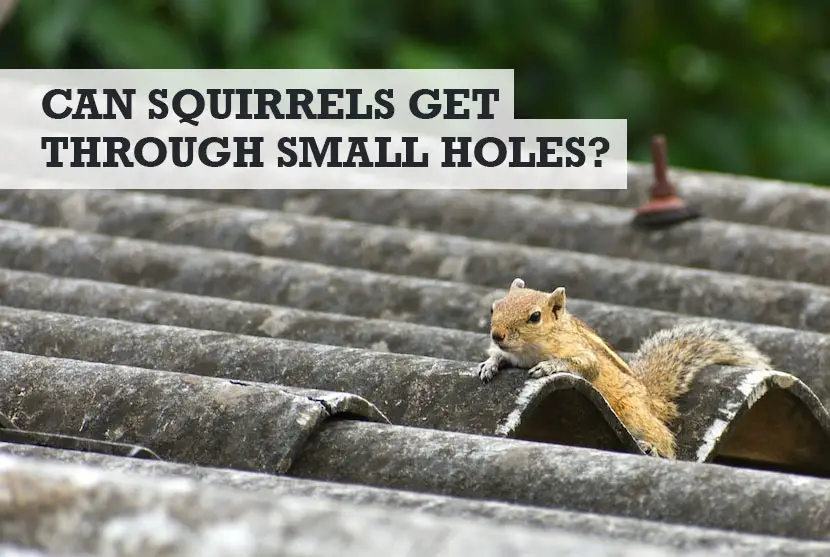Last year we had a problem with squirrels coming into our backyard, running along a fence, and then jumping onto a pitched roof on our house. One on the roof, they were able to get into the eaves and the loft attic space due to holes that were already there.
There is a happy end to the story. I did manage to stop the squirrels getting into the small holes, but what surprised was just how small a gap they can squeeze through.
Squirrels can squeeze through small holes as tight as 1 and a quarter inch wide. This is based on the average squirrel skull being is 1.25 inches at the widest point. If a squirrel can get its head in a small hole, it will be able to squeeze the rest of its body through.
Sounds crazy doesn’t it, but it’s true.
The smallest hole a squirrel can get through is one that is big (or small enough) for their head to fit through. Once a squirrel squeeze through tight spaces headfirst, it can then contort the rest of the body to get through.
How big is the average squirrel head / skull?
Of course, how small of a hole can a squirrel go through in your roof will depend on what type of squirrels you are dealing with – and how big their heads are.
Here are common squirrel types, and the size of their skulls on average.
Ground squirrel
- Average Skull Length: 4.3 cm (1.6 inches)
- Average Skull Width: 2.5 cm (0.9 inches)
- Average Skull Height: 2.1 cm (0.8 inches)
Flying squirrel
- Average Skull Length: 3.5 cm (1.4 inches)
- Average Skull Width: 2.2 cm (0.9 inches)
- Average Skull Height: 1.9 cm (0.7 inches)
Tree squirrel
- Average Skull Length: 6.5 cm (2.5 inches)
Based on what we see above, it’s possible that a small flying squirrel could get into small holes as little as 0.7 inches in diameter!
What that means for you as a homeowner, is you need to firstly take steps to stop squirrels getting into your backyard. Once they are on your lawn digging holes, the next phase is your house, given how warm and cosy it is.
I’ve previously published a step-by-step guide which explains how to stop squirrels digging holes in your lawn. This will help you to discourage them from coming into your backyard.
Handy Hint: I’ve also written a guide which shows the differences between rat and squirrel holes.
Once you stop them coming into your backyard and digging holes, you can then address holes in your roof and attic space. Below explains how.
How do you seal a squirrel hole?
Before you consider sealing up the small holes that squirrels are squeezing through to get into your house, you need to get them out of the roof space.
If you seal with them still in, they will either chew more holes to escape, or die in there leaving a terrible smell.

Squirrels are most active in the early mornings and late afternoons and will leave their nests to get food. Once you see them leave, you can seal the holes.
Popular methods for sealing squirrel holes include:
- Stainless steel mesh
- Sheet metal
- Aluminum flashing
These can’t be chewed through and are ideal for sealing larger holes that squirrels get through.
You can then use caulk or foam sealant to seal any smaller gaps. With caulk and foam, you can easily paint over them, so it doesn’t notice.
Once the holes are sealed, you can stop them getting back onto the roof. Do this by making sure any trees near your house are no closer than 5 feet – you might need to cut branches back stop them jumping onto the roof.
Handy Hint: Here’s how rats can squeeze under closed doors.
What size mesh can a squirrel fit through?
If you decide to use mesh, you might want to think again. As I’ve established, squirrels can squeeze through tight spaces that are on average no bigger than 1.25 inches wide.
Don’t use mesh unless it’s smaller than 0.7 inches to be completely certain squirrels can’t squeeze through.
Can squirrels chew through mesh though?
Metal mesh like chicken wire often won’t be strong enough to stop squirrels chewing through. Most rodents can chew through it.
Instead, I recommend galvanized mesh and something more heavy duty.
Can a squirrel fit through 1 inch chicken wire?
Some very small squirrels will be able to get their head through 1 inch chicken wire, but it’s very rare as the average skull size for a squirrel is wider than that.
Can squirrels fit through small cracks?
Yes, squirrels can fit through cracks, but not small ones. It’s unlikely that most squirrels would be able to fit through a masonry crack of 1 inch or less, as their heads won’t squeeze through.
More backyard guides…
- How to stop squirrels digging up bulbs
- How to stop squirrels digging holes in your grass
- How small a hole a rat can fit through
Image of squirrel on roof from https://unsplash.com/photos/JUozIpPU8G4

